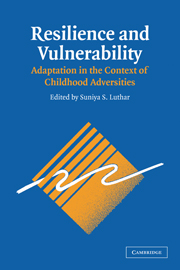Book contents
- Frontmatter
- Contents
- List of Contributors
- Foreword by Dante Cicchetti
- Preface
- 1 A Resilience Framework for Research, Policy, and Practice
- PART I FAMILIAL ADVERSITIES: PARENTAL PSYCHOPATHOLOGY AND FAMILY PROCESSES
- 2 Young Children with Mentally Ill Parents: Resilient Developmental Systems
- 3 Risk and Protective Factors for Children of Depressed Parents
- 4 Resilience and Vulnerability among Sons of Alcoholics: Relationship to Developmental Outcomes between Early Childhood and Adolescence
- 5 Maternal Drug Abuse versus Other Psychological Disturbances: Risks and Resilience among Children
- 6 Resilience to Childhood Adversity: Results of a 21-Year Study
- 7 Sequelae of Child Maltreatment: Vulnerability and Resilience
- 8 Risk and Resilience in Children Coping with Their Parents' Divorce and Remarriage
- 9 Correlational and Experimental Study of Resilience in Children of Divorce and Parentally Bereaved Children
- PART II EXOSYSTEMIC AND SOCIODEMOGRAPHIC RISKS
- PART III COMMENTARIES
- Index
- References
7 - Sequelae of Child Maltreatment: Vulnerability and Resilience
Published online by Cambridge University Press: 05 June 2012
- Frontmatter
- Contents
- List of Contributors
- Foreword by Dante Cicchetti
- Preface
- 1 A Resilience Framework for Research, Policy, and Practice
- PART I FAMILIAL ADVERSITIES: PARENTAL PSYCHOPATHOLOGY AND FAMILY PROCESSES
- 2 Young Children with Mentally Ill Parents: Resilient Developmental Systems
- 3 Risk and Protective Factors for Children of Depressed Parents
- 4 Resilience and Vulnerability among Sons of Alcoholics: Relationship to Developmental Outcomes between Early Childhood and Adolescence
- 5 Maternal Drug Abuse versus Other Psychological Disturbances: Risks and Resilience among Children
- 6 Resilience to Childhood Adversity: Results of a 21-Year Study
- 7 Sequelae of Child Maltreatment: Vulnerability and Resilience
- 8 Risk and Resilience in Children Coping with Their Parents' Divorce and Remarriage
- 9 Correlational and Experimental Study of Resilience in Children of Divorce and Parentally Bereaved Children
- PART II EXOSYSTEMIC AND SOCIODEMOGRAPHIC RISKS
- PART III COMMENTARIES
- Index
- References
Summary
To grow into competent and productive adults, children must learn to regulate their emotions and their behavior, to form a coherent, positive sense of self, and toform and maintain relationships with other people. A substantial body of evidence indicates that consistent, responsive parenting contributes to children's ability to master these developmental tasks (Lord, Eccles, & McCarthy, 1994; Raver, 1996). In maltreating families, however, parental care does not meet children's basic needs for physical sustenance and protection, emotional security, and social interaction. Thus, maltreatment constitutes a significant deviation from the average expectable or species-typical environment, as defined by community norms and by medical, legal, and social scientific standards (National Research Council, 1993). Developmental theory on the influence of early caregiving predicts that such conditions predispose children to a variety of difficulties in adjustment and adaptation (Cicchetti & Lynch, 1995; Scarr, 1992).
Empirical evidence supports this contention: Maltreatment during childhood is associated with an increased risk for internalizing problems, such as depression and anxiety (Lynch & Cicchetti, 1998; McGee, Wolfe, & Wilson, 1997; Toth, Manly, & Cicchetti, 1992), and externalizing problems including aggression, delinquency, and antisocial behavior (Herrenkohl, Egolf, & Herrenkohl, 1997; Widom, 1989). Maltreated children encounter more difficulties in developing autonomy and self-esteem (Egeland, Sroufe, & Erickson, 1983) and in relationships with others, including peers (Cicchetti, Lynch, Shonk, & Manly, 1992; Rogosch, Cicchetti, & Aber, 1995; Salzinger, Feldman, Hammer, & Rosario, 1993).
Information
- Type
- Chapter
- Information
- Resilience and VulnerabilityAdaptation in the Context of Childhood Adversities, pp. 156 - 181Publisher: Cambridge University PressPrint publication year: 2003
References
Accessibility standard: Unknown
- 66
- Cited by
